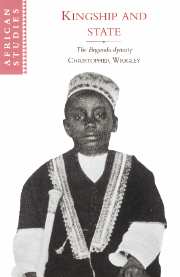Book contents
- Frontmatter
- Contents
- List of illustrations
- Preface
- Notes on language
- List of abbreviations
- 1 Preamble
- 2 The story and its making
- 3 Introduction to myth
- 4 Introduction to Buganda
- 5 The remoter past
- 6 Genesis
- 7 The cycle of the kings
- 8 Fragments of history
- 9 Foreign affairs
- 10 The making of the state
- 11 Reflections
- Notes
- Bibliography
- Index
- Other books in the series
3 - Introduction to myth
Published online by Cambridge University Press: 12 January 2010
- Frontmatter
- Contents
- List of illustrations
- Preface
- Notes on language
- List of abbreviations
- 1 Preamble
- 2 The story and its making
- 3 Introduction to myth
- 4 Introduction to Buganda
- 5 The remoter past
- 6 Genesis
- 7 The cycle of the kings
- 8 Fragments of history
- 9 Foreign affairs
- 10 The making of the state
- 11 Reflections
- Notes
- Bibliography
- Index
- Other books in the series
Summary
The relationship between history and myth has been a sensitive one for Westerners, since a fusion, or confusion, of these two categories lies at the root of our culture, the classically mythical themes of the Incarnation and the Resurrection having been attached to the memory of a man who undoubtedly said and did some of the things that are reported of him and very probably was indeed crucified under Pontius Pilate. In itself, such an attachment was not uncommon; but Christians assert that their myths are true, that the whole story must be taken as historical reality. That position was not reached easily, and the effort underlies the great doctrinal controversies of the early Christian centuries. But gradually the divergent heresies of the Arians, for whom Christ was wholly human (that is, historical), and of the Monophysites, for whom he was wholly mythical (that is, divine), were repressed or marginalised and the Catholic synthesis prevailed. The balance was, however, disturbed by the Reformation. For although the Protestants did not challenge trinitarian orthodoxy they sought with varying degrees of urgency to divest Christianity of its more obviously mythical accretions (as they saw them), such as Christmas and the doctrine of transsubstantiation, in order to stress the redemptive history.
By the end of the nineteenth century the old heresies had reappeared on the frontier between radical Protestantism and unbelief. Rationalists now questioned whether Jesus had been anything other than a man, while the ‘Christ-myth’ advocates doubted whether he had ever been a man at all.
- Type
- Chapter
- Information
- Kingship and StateThe Buganda Dynasty, pp. 43 - 56Publisher: Cambridge University PressPrint publication year: 1996

